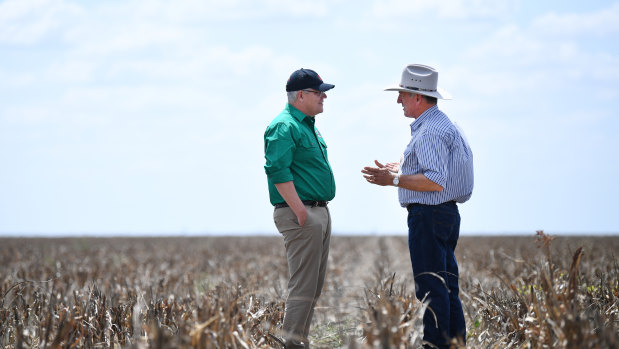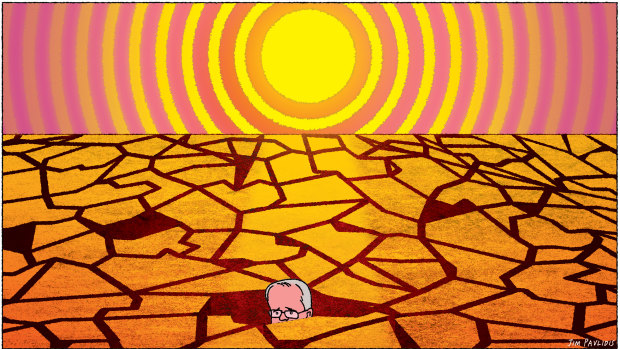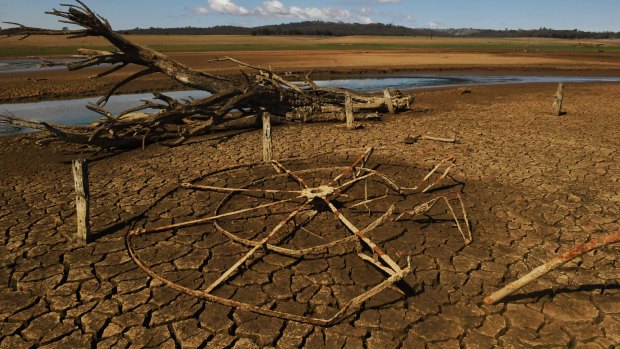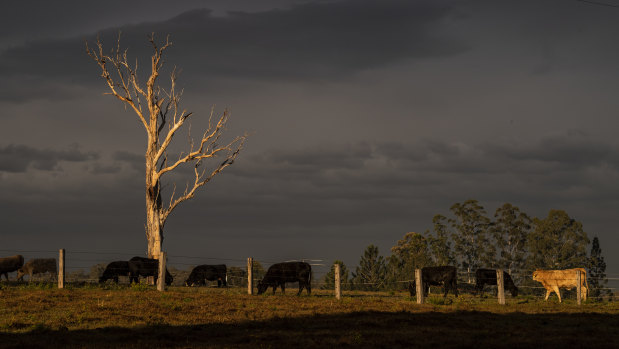This was published 5 years ago
Opinion
Inadequate drought preparation may prove to be political disaster too
Tony Walker
Columnist and award-winning foreign correspondentPanicky. That’s a word to describe the Morrison government’s response to a national drought emergency. Lack of rain, arid conditions, scorching winds and higher temperatures are contributing to an evolving disaster against the background of a contentious climate change debate. This is a challenge that will become increasingly difficult for the governments, federal and state, to ignore as water supplies run down in New South Wales towns such as Dubbo and Queensland towns such as Stanthorpe. Risks of bushfire will be further elevated.

Prime Minister Scott Morrison with farmer David Gooding on his drought-affected property near Dalby, Queensland.Credit: AAP
Judging by Bureau of Meteorology forecasts, drought over much of eastern Australia is set to surpass all others in living memory going back to the beginning of record keeping. In other words, things may get a lot worse before they get better. What is left unspoken by government officials and farm representatives is this aridity will prove to be the new normal.
Let’s repeat these words in capitals: NATIONAL DROUGHT EMERGENCY. It might also be observed that no less than a drought emergency, this is a POLITICAL EMERGENCY for the Morrison government. Governmental responses, both federal and state, to a catastrophic dry across central and northern New South Wales and southern Queensland have been unfocused, according to farm representatives. Tony Mahar, chief executive of the National Farmers’ Federation, the peak body for Australian farmers, awards federal and state governments a "fail" when it comes to developing a national drought strategy to deal with emergencies. "No government, red or blue, has successfully nailed drought policy," Mahar tells me.
Government inattention may well reflect agriculture’s diminishing share of the national economy at just three per cent of Gross Domestic Product. On the other hand, 1.6 million jobs reside in the complete agricultural supply chain. Prime Minister Scott Morrison’s dash – on his return to Australia from a state visit to the United States – to Dalby in the heart of drought-stricken southern Queensland to announce a $100-million relief package as part of an overall $7-billion allocation reflects government political concerns.
Morrison himself would not need reminding that the 2001-2010 millennium drought contributed to John Howard’s undoing, given he was perceived – rightly or wrongly – to be indifferent to climate change. At least six Coalition seats are at risk in the face of seething local anger over water mismanagement, or no management at all. In all of this, what tends to be overlooked is that the government has a wafer-thin majority of one after the Speaker is excluded.

Illustration: Jim PavlidisCredit:
In fairness, Morrison's flurry of drought-related activity goes back to him becoming Prime Minister after taking over from Malcolm Turnbull. All this begs the question: what have conservative governments, and before them Labor governments, done to prepare the country for a national drought emergency of this magnitude? The short answer is not nearly enough, and scandalously so.
Space is not available for a detailed breakdown of the government’s belated drought relief efforts, but, in summary, it has allocated $5 billion for a Future Drought Fund under legislation that was enacted in July. The remaining $2 billion of the $7 billion the government says it has set aside for drought relief is being dribbled out in sustenance payments to farmers and funding for everything from dams to pest control. The impression is one of ad hocery.
David Littleproud, the able and hard-pressed minister for drought, resists describing drought conditions as a natural disaster on the basis that these are slow-moving events compared with one-off cataclysmic force majeure episodes like cyclones, or earthquakes or bushfires. Technically, he is right. However, if you asked people in drought-ravaged areas, they would be hard put to differentiate between an emergency or a natural disaster, slow-moving or not.

Lake Burrendong, one of NSW's most vital water catchments, is at 4.4 per cent.Credit: Nick Moir
I should note that I’ve started sending modest donations to a farmer in the Stanthorpe area of Queensland to help him keep his breeding stock alive. I had gone to his farm to interview him for this newspaper’s Good Weekend magazine but couldn’t bring myself to tell his story; it would have seemed like an intrusion into private grief. On my visit, heartbreakingly, he showed me the carcasses of lambs he had nurtured from birth with their throats ripped out by foxes or wild dogs. Bad enough to wake up to a cloudless sky!
Ministers argue, as they do, that under Section 100 of the Constitution that vests responsibility in the states for the "reasonable use of the waters of rivers for conservation or irrigation", Canberra’s ability to manage water issues is lessened. This strikes you as disingenuous. After all, the Commonwealth holds the purse strings when it comes to funding nation-building infrastructure projects. Successive governments – both Coalition and Labor; both federal and state – have clearly failed as custodians of the national water security.
This is a failure that should make people’s blood boil. Deputy Prime Minister Michael McCormack’s remark last month that Australia needed to "get serious" about water security took your breath away. Don’t take my word for it. These are the numbers: since 2003, just 20 larger-capacity dams have been built in Australia, 16 in Tasmania. That is just four in the rest of the country. Four!
Let me give you another number that should be keeping policy-makers awake at night. Littleproud tells me that unless states start building dams under a $1.3 billion National Water Infrastructure Development Fund, "water storage capacity" will fall by 37 per cent by 2030. As things stand, water storage is 25 per cent less per person now than it was 20 years ago. In Victoria, for example, where Premier Dan Andrews inexplicably said this week "dams don’t bring rain", water availability will fall from 1.93 to 1.58 megalitres per person over the next decade, according to Littleproud.
This returns us to the political consequences. Barnaby Joyce – former leader of the National Party, member for the drought-afflicted seat of New England and formerly the government’s drought envoy – has warned colourfully of a political wipeout in Coalition seats in NSW.
"It’s no good talking about the crisis when it arrives; it should’ve been dealt with years ago … it will be political annihilation if we don’t," Joyce told The Guardian. His colleagues have found his latest remarks surprising since they blame him for the government’s mismanagement of water issues dating from his tenure as agriculture minister. This includes oversight of what is widely regarded as a debacle surrounding the allocation of water in the Murray-Darling Basin.
Joyce did not return a phone call for comment.
In 2018, the Council of Australian Government agreed to a new National Drought Agreement aimed at "enhancing long-term preparedness and resilience" and "preparing for climate change and variability". Climate change is the huge unknown variable in the drought story.
In the case of the NDA, the question is whether it is both too little and too late. This is especially so given a swirling climate change debate in which polls indicate farmers are increasingly sensitive to the issue. Littleproud lost skin in the climate debate when he appeared to question the science on being asked about the recent Queensland bushfires that ravaged areas north of Brisbane. Now he says he accepts the science but remains unconvinced whether climate change is manmade. This would seem a contradiction.

Drought-affected country near Grafton in NSW.Credit: Louise Kennerly
Given the recent focus on climate change issues and its resonance in drought-stricken rural areas, partly driven by the attention Swedish teenage activist Greta Thunberg has received, the drought minister will come under further pressure on the issue.
Finally, the latest Bureau of Meteorology bulletin provides little encouragement to believe that drought conditions will ease in the short term. The BOM reports the lowest rainfall on record extending from the Great Dividing Range as far as Dubbo and Walgett in central NSW. This is a huge swathe of the country under some of the most extreme drought conditions in the history of white settlement. Only the peak of the terrible 1900-02 "Federation Drought" was worse.
This is bad enough but meteorologists at the BOM are also reporting that a phenomenon known as sudden strategic warming above the South Pole risks contributing to a further deepening of the drought. The SSW effect would cause warmer westerly winds to track north, intensifying drought conditions in southern Queensland and northern New South Wales. If those forecasts prove correct, distinctions between a natural disaster and a national emergency will certainly become moot. Regardless, in a cloudless sky, these weather conditions will constitute an accelerating political emergency.
Tony Walker is a Vice-Chancellor's Fellow at La Trobe University.